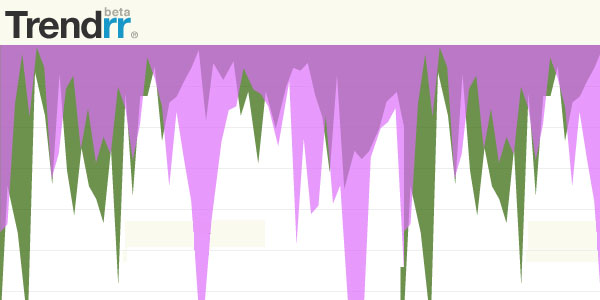All captions taken from The Atlas of the Real World:
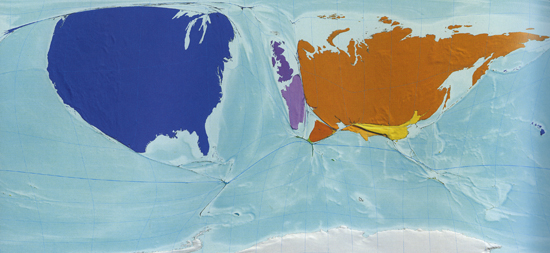
Nuclear Weapons: The size of each territory indicates the number of known or suspected strategic nuclear weapons*
“In 2002 eight territories were known or suspected to have strategic nuclear weapons: the United States, Russia, France, China, the United Kingdom, Israel, India and Pakistan… The United States, which has the largest number of nuclear weapons, has 240 times more than Pakistan, which has the fewest.” *Strategic nuclear weapons, estimated total, 2002.
——————————————
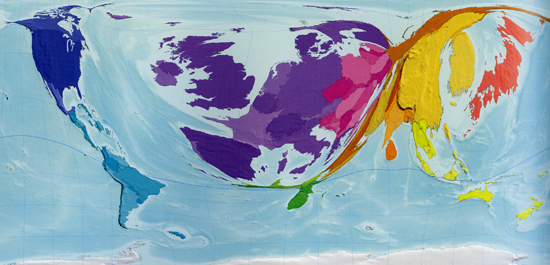
Books Published: The size of each territory shows the number of new book titles published each year*
“Each new book published is counted only once on this map, regardless of how many copies it sells… A book is defined as having at least 50 pages; a pamphlet has 5 to 49 pages. Publications with fewer than 5 pages are not shown on this map. Worldwide, about a million new book titles were published in 1999, with the largest numbers published in the United Kingdom, China and Germany. Overall, the map is dominated by Western Europe, which is home to a number of well established publishing houses.” *Books titles published, number per million people, 1999.
——————————————

Internet Users in 1990: The size of each territory indicates the number of people using the infant internet in 1990*
“Just 3 million people worldwide had access to the internet [in 1990]: 73% of these were in the United States and 15% in Western Europe, with just a few in other places such as Canada, Australia, Japan, South Korea and Israel and practically no access anywhere else.” *Internet users in 1990, thousands.
——————————————
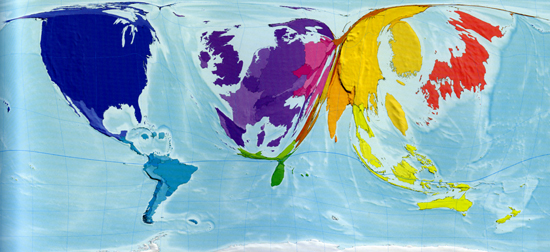
Internet Users in 2002: The size of each territory indicates the number of internet users in 2002, by which time its reach and sophistication had increased dramatically*
“The number of people using the internet saw a 200-fold increase between 1990 and 2002. By 2002 there were 631 million internet users worldwide. The distribution of users also changed radically… By 2002 there were substantial numbers of internet users also in the Asia-Pacific and Australasia, South Asia, South America, Eastern Europe and China, and small but significant numbers in Northern Africa, East and Southern Africa, and the Middle East and Central Asia.” *Internet users in 2002, users per 1,000 people, 2002.
——————————————
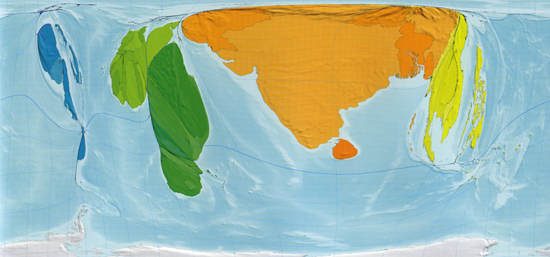
Forest Depletion: The size of each territory indicates the annual rate of depletion of forests, measured in terms of US dollar value at current prices*
“As quantified here, forest depletion is the net rate of loss of forests as a result of tree felling that is not offset by regrowth. The loss is measured in terms of the market value of the trees in the form of untreated round timber. In other words this map shows, at the territory level, the dollar value of wood that is not sustainably harvested… Almost half of the world total (46%) occurs in India, where the annual timber depletion exceeds that of the next 25 countries combined, althought the population of India is also almost as large as the combined population of those 25 other territories.” *Forest depletion, US$ billion, 2003.
——————————————
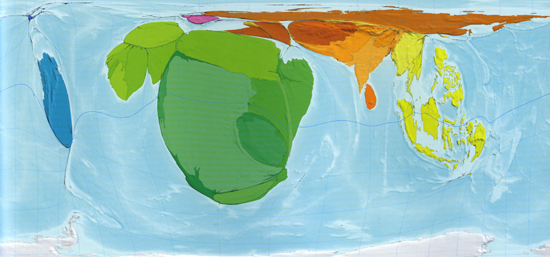
War Deaths in 2002: The size of each territory indicates the number of deaths directly attributable to armed conflict in 2002*
“In 2002 there were an estimated 172,000 war deaths worldwide. The majority of territories recorded none; the deaths shown here occurred in only 80 of the 200 territories, and 70% of them occurred in just 9 territories. The Democratic Replublic of Congo bore the largest share of war deaths in 2002, at 26%. As a fraction of total population Burundi was hardest hit, with 1.2 people in every 1,000 dying.” *War deaths 2002, thousands of people killed in wars.
——————————————
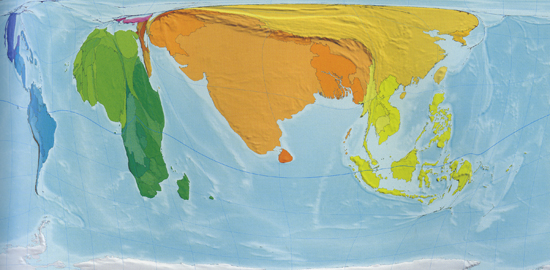
Abject Poverty - People Living on US$2 a Day: The size of each territory shows the number of people living on US$2 a day or less, adjusted for local purchasing power: barely enough to survive, let alone thrive*
“In 2002, 43% of the world’s population lived in US$2 a day or less… Where almost the entire population of a territory lives on incomes at this level, it is unsurprising if undernourishment is high, the level of education is low and life expectancy short. In both Nigeria and Mali, 9 out of every 10 people subsist on less than US$2 a day.” *Living on US$2 a day or less, millions of people.
——————————————
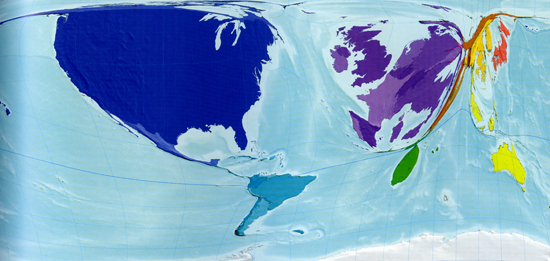
Number of People Living on More Than US$200 a Day: The size of each territory indicates the number of living on more than US$200 a day, adjusted for local purchasing power. Over half of these high earners live in the United States*
“A majority (61%) of the Japanese population live in households with daily incomes between US$50 and US$100, adjusted for purchasing power parity. North American and Western Europe are also particularly large on this map, while South Asia and Central Africa have almost completely disappeared.” *Living on over US$200 a day, % of population.
——————————————
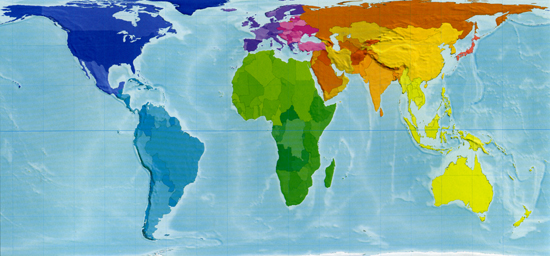
Land Area: The size of each territory represents exactly its land area in proportion to that of the others, giving a strikingly different perspective from the Mercator projection most commonly used
All images reproduced with permission.

The Atlas of the Real World is published next week from Thames & Hudson, (£29.95)
